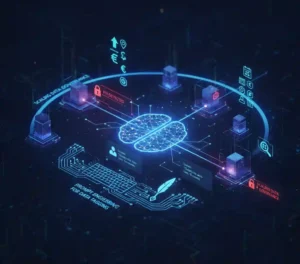If you’re eyeing a spot in the fast-paced world of tech, becoming a machine learning engineer might just be your ticket. This role blends coding smarts with data wizardry to create systems that learn and improve on their own. But where do you start? That’s where a solid machine learning engineer roadmap comes in handy. It’s not about cramming theory overnight, it’s about building skills that stick and open doors.
In 2025, the demand for folks who can wrangle AI is skyrocketing. Think about it: companies are pouring resources into smart tech to stay ahead. Whether you’re switching careers or fresh out of school, this guide walks you through the essentials. We’ll cover everything from basics to advanced tricks, with real examples to keep things grounded. Ready to roll up your sleeves? Let’s get into it.
Table of Contents
Why Jump Into the Machine Learning Engineer World Right Now?
Picture this: you’re at the forefront of tech that’s changing how we live, from personalized ads to self-driving cars. But why 2025 specifically? The job market is exploding. In Q1 2025 alone, there were over 35,000 AI-related job openings in the U.S., marking a 25% jump from the year before. And AI job postings more than doubled from January to April, hitting nearly 139,000. That’s not fluff, it’s a real opportunity.
Salaries aren’t shabby either. On average, machine learning engineers pull in around $158,000 a year in the U.S., with some spots offering up to $170,000 base pay. Factor in bonuses and stock, and you’re looking at total comp that can top $200,000 for experienced pros. Why the high pay? These roles drive big wins for businesses, like cutting costs or boosting user engagement.
Take Netflix, for example. Their recommendation engine, powered by machine learning, keeps viewers hooked and reduces churn. It’s estimated to save them $1 billion annually by suggesting shows you can’t resist. That’s the kind of impact you could make. But to get there, you need a clear ai career path. This machine learning engineer roadmap lays it out, focusing on ML skills 2025 demands like generative AI and cloud deployment.
Step 1: Nail the Programming Basics
First things first: you can’t build models without a strong coding foundation. Python is your go-to here; it’s straightforward and packed with libraries that make life easier. If you’re new, start with the basics: variables, loops, functions. Don’t just read about it; code daily.
Why Python? It’s used in 90% of machine learning projects because of its simplicity and community support. Aim to get comfy with object-oriented programming, too. Resources like freeCodeCamp’s Python course or Codecademy can get you up to speed in weeks.
Tip: Practice on platforms like LeetCode. Solve 50 easy problems to build confidence. Remember, as you learn machine learning step by step, coding is the bedrock.
Step 2: Master the Math Behind the Magic
Math might sound intimidating, but it’s what makes models tick. Focus on linear algebra for handling data matrices, calculus for optimization, and probability/statistics for understanding uncertainty.
For instance, probability helps in Bayesian networks, which power spam filters. A real-world example: Google’s PageRank algorithm uses linear algebra to rank web pages. Without these, you’ll struggle with why models fail.
Actionable tip: Use Khan Academy for bite-sized lessons. Spend 2-3 hours a day for a month. Track progress with quizzes. This step in your machine learning engineer roadmap ensures you grasp why algorithms work, not just how to run them.
Step 3: Get Hands-On with Data Handling
Data is the fuel for machine learning. Learn to clean, wrangle, and query it. SQL is key for pulling data from databases, while pandas in Python handles manipulation.
In 2025, with big data everywhere, skills like ETL (Extract, Transform, Load) are must-haves. Case study: Amazon uses machine learning for fraud detection, processing millions of transactions daily. They rely on clean data to spot anomalies in real-time.
Bullet points for quick wins:
- Master SQL joins and aggregations.
- Practice data cleaning: handle missing values, outliers.
- Use Jupyter notebooks for exploratory analysis.
This builds on your ai career path by making you efficient with real datasets.
Step 4: Dive into Core Machine Learning Concepts
Now, the fun part: learn machine learning step by step with fundamentals. Cover supervised learning (regression, classification), unsupervised (clustering), and reinforcement learning.
Understand algorithms like decision trees or k-means. A tip: implement them from scratch before using libraries, as it cements knowledge.
Example: Starbucks’ loyalty program uses clustering to segment customers and personalize offers, boosting retention by 20%. That’s unsupervised learning in action.
Resources: Andrew Ng’s Coursera course is gold. Dedicate time to experiments—tweak parameters and see results.
Step 5: Tool Up with Essential Libraries
Libraries speed things up. Start with NumPy for arrays, Pandas for dataframes, Matplotlib/Seaborn for visuals, and Scikit-learn for basic models.
In ml skills 2025, knowing these is non-negotiable. For example, Scikit-learn’s pipelines streamline workflows, reducing errors.
Tip: Build a simple predictor, like housing prices with linear regression. Upload to GitHub; it’s great for your portfolio.
Case study: PayPal uses Scikit-learn-like tools for fraud detection, analyzing patterns to block shady transactions.
Step 6: Tackle Deep Learning
Level up to neural networks. Learn TensorFlow or PyTorch—these dominate in 2025.
Focus on CNNs for images, RNNs/LSTMs for sequences. With generative AI booming, understand transformers too.
Real example: Medical imaging with CNNs spots tumors in X-rays faster than humans, improving diagnostics.
Tip: Use Kaggle datasets for practice. Compete in a beginner contest to apply concepts.
This step in the machine learning engineer roadmap preps you for cutting-edge roles.
Step 7: Explore Advanced Topics
Branch out to NLP, computer vision, and generative models. Tools like Hugging Face make NLP accessible.
In 2025, GenAI skills are hot, think ChatGPT-style apps.
Case study: Uber’s routing uses reinforcement learning to optimize paths, saving time and fuel.
Bullet points:
- Study BERT for text analysis.
- Experiment with GANs for image generation.
- Learn ethics: bias in models can lead to unfair outcomes.
Keep experimenting to stay sharp.
Step 8: Build and Showcase Projects
Theory alone won’t cut it. Create projects like a sentiment analyzer or image classifier.
Use Git for version control, it’s an ML Skills 2025 essential.
Tip: Document everything in a README. Host on GitHub Pages.
Example: A hobbyist built a stock predictor and landed an internship by sharing it on LinkedIn.
This proves you can become a machine learning engineer who delivers.
Step 9: Learn MLOps and Deployment
Productionize models with MLOps. Use Docker for containers, Kubernetes for scaling, AWS/GCP for cloud.
In 2025, deployment is key, models must run reliably.
Case study: NASA’s ML for satellite imagery processes data in real-time for disaster response.
Tip: Deploy a model to Heroku. Monitor with tools like Prometheus.
This rounds out your ai career path.
Step 10: Network and Land the Job
Polish your resume, highlight projects. Network on LinkedIn, attend meetups.
Prep for interviews: explain models, solve coding challenges.
Stat: Machine learning engineer postings hit 2,951 in mid-2025.
Tip: Tailor applications. Follow up after interviews.
You’ve got this, follow this machine learning engineer roadmap, and doors will open.
Wrapping It Up
There you have it: a no-nonsense machine learning engineer roadmap to guide your journey. From coding basics to deployment, these steps build a rock-solid foundation. Stay consistent, practice often, and you’ll see progress. The field is wide open in 2025. Grab your spot.
FAQs
What are the prerequisites to become a machine learning engineer in 2025?
You need basic programming knowledge, preferably in Python, and some math background. No advanced degree required, but dedication to learning helps. Start with free online resources to test the waters.
How long does it take to learn machine learning step by step and get a job?
It varies, 3-6 months for basics if full-time, up to a year for job-ready skills. Focus on projects and networking to speed things up. Many land entry roles after intensive bootcamps.
What ml skills 2025 should I prioritize for high-paying roles?
Emphasize Python, deep learning frameworks, MLOps, and cloud computing. Generative AI and ethical considerations are rising fast. Keep an eye on trends like edge AI.
Is an ai career path worth pursuing if I'm from a non-tech background?
Absolutely. Many switch successfully with self-study. Build a portfolio to show skills. Communities like Reddit’s r/MachineLearning offer support and advice.
How can I stay updated on the machine learning engineer roadmap changes?
Follow blogs like Towards Data Science, attend conferences like NeurIPS, and join Discord groups. Experiment with new tools regularly to keep your edge sharp.


















